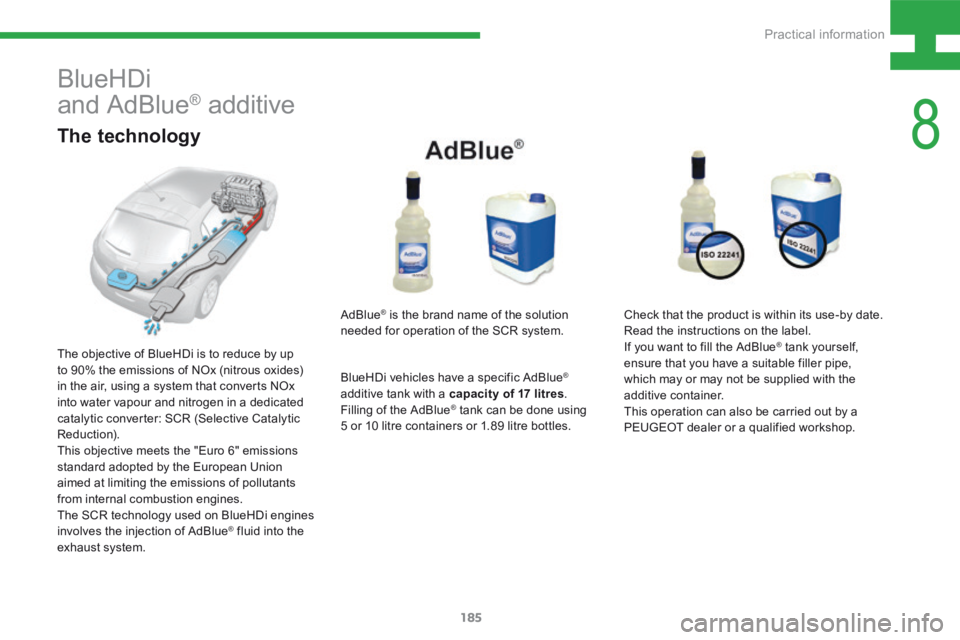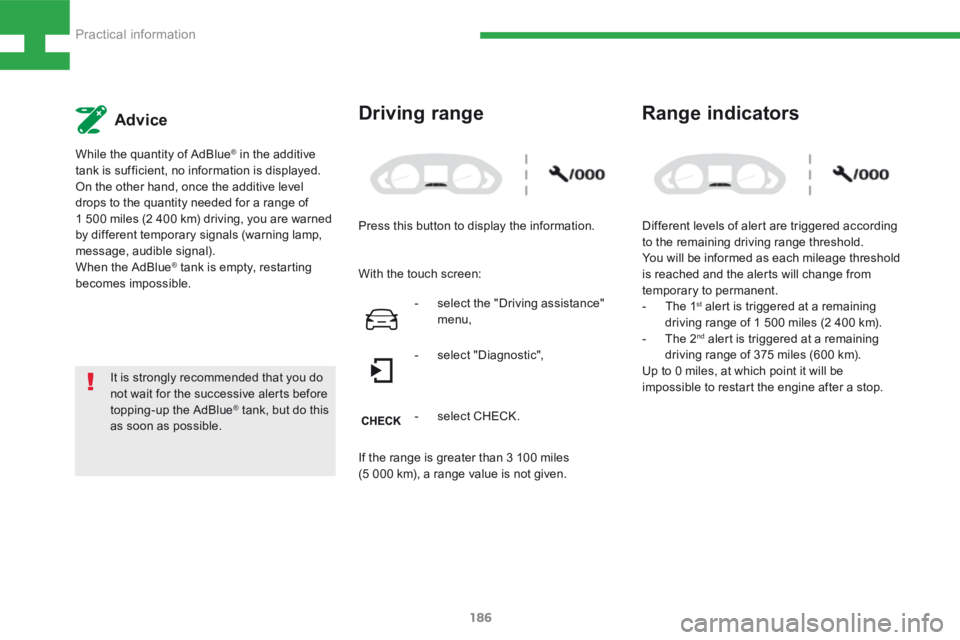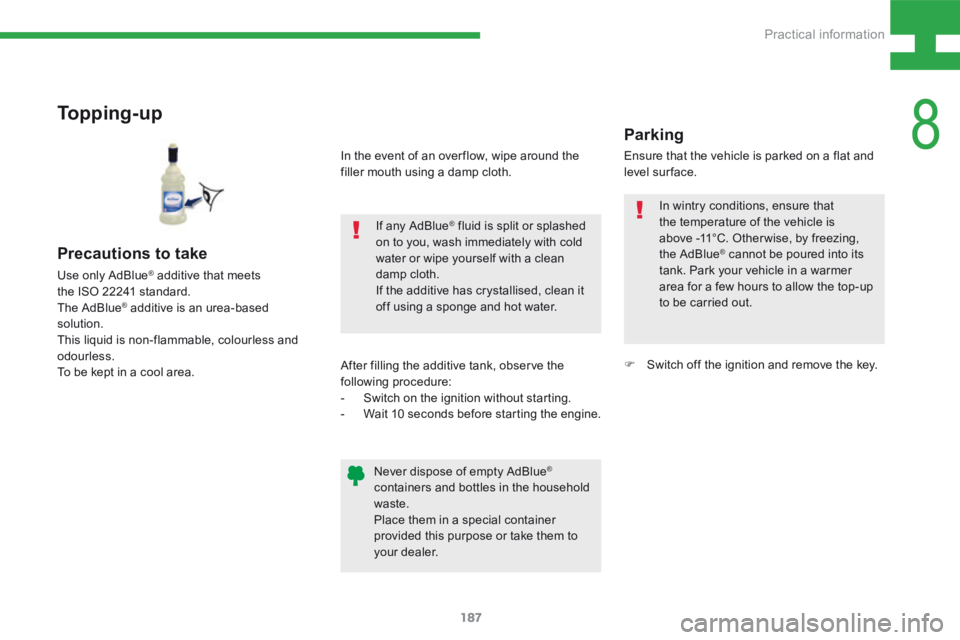Page 181 of 341
179
208_en_Chap08_Informations-pratiques_ed01-2015
* Capacity with oil filter replacement.
** Affaire version.
Diesel engines
EngineGearbox SpeedsEngine oil capacity*
(litres) Unbraked trailer (kg) Recommended nose
weight (kg)
1.4 HDi 68 Manual 53.75400 / 600** 29
1.4 e- HDi 68 Electronic 53.75500 / 600** 29
1.6 HDi 75 Manual 53.75 --
1.6 HDi 92 Manual 53.75 --
1.6 e- HDi 92 Manual
53.75570 / 600** 46
Electronic 63.75 580 46
1.6 e- HDi 115 Manual63.75 580 46
1.6 BlueHDi 120 Manual6---
8
Practical information
Page 186 of 341

184
208_en_Chap08_Informations-pratiques_ed01-2015
On vehicle fitted with HDi engines, the fuel
system must be primed if you run out of fuel.
For versions with a manual priming pump,
refer to the drawing of the corresponding
underbonnet view.
If the tank on your vehicle is fitted with
a misfuel prevention device, refer to the
corresponding section.
Running out of fuel (Diesel)
If the engine does not start first time,
don't keep trying. Start the procedure
again from the beginning.
1.4 HDi engine
F Add at least five litres of Diesel fuel to the
tank.
F Open the bonnet.
F Press and release the priming pump until
resistance is felt (there may be resistance
on the first press).
F Operate the starter motor to start the
engine.
F Close the bonnet.
1.6 HDi engine
(except BlueHDi version)
F Add at least five litres of Diesel fuel to the
tank.
F Open the bonnet.
F If necessary, unclip the styling cover for
access to the priming pump.
F Squeeze and release the priming pump
repeatedly until resistance is felt (there
may be resistance at the first press).
F Operate the starter to start the engine
(if the engine does not start at the first
attempt, wait around 15 seconds before
trying again).
F If the engine does not start after a few
attempts, operate the priming pump again
then start the engine.
F Refit the styling cover and clip it in place.
F Close the bonnet.
1.6 HDi engine
(BlueHDi version)
F Add at least five litres of Diesel fuel to the
tank.
F Switch the ignition on (without starting the
engine).
F Wait around 6 seconds and switch off the
ignition.
F Repeat the operation 10 times.
F Operate the starter motor to start the
engine.
Practical information
Page 187 of 341

185
208_en_Chap08_Informations-pratiques_ed01-2015
BlueHDi
and AdBlue
® additive
The technology
AdBlue® is the brand name of the solution
needed for operation of the SCR system.
BlueHDi vehicles have a specific AdBlue
®
additive tank with a capacity of 17 litres .
Filling of the AdBlue
® tank can be done using
5 or 10 litre containers or 1.89 litre bottles.
The objective of BlueHDi is to reduce by up
to 90% the emissions of NOx (nitrous oxides)
in the air, using a system that converts NOx
into water vapour and nitrogen in a dedicated
catalytic converter: SCR (Selective Catalytic
Reduction).
This objective meets the "Euro 6" emissions
standard adopted by the European Union
aimed at limiting the emissions of pollutants
from internal combustion engines.
The SCR technology used on BlueHDi engines
involves the injection of AdBlue
® fluid into the
exhaust system. Check that the product is within its use-by date.
Read the instructions on the label.
If you want to fill the AdBlue
® tank yourself,
ensure that you have a suitable filler pipe,
which may or may not be supplied with the
additive container.
This operation can also be carried out by a
PEUGEOT dealer or a qualified workshop.
8
Practical information
Page 188 of 341

186
208_en_Chap08_Informations-pratiques_ed01-2015
Advice
While the quantity of AdBlue® in the additive
tank is sufficient, no information is displayed.
On the other hand, once the additive level
drops to the quantity needed for a range of
1 500 miles (2 400 km) driving, you are warned
by different temporary signals (warning lamp,
message, audible signal).
When the AdBlue
® tank is empty, restarting
becomes impossible. Different levels of alert are triggered according
to the remaining driving range threshold.
You will be informed as each mileage threshold
is reached and the alerts will change from
temporary to permanent.
-
The 1
st alert is triggered at a remaining
driving range of 1 500 miles (2 400 km).
- The 2
nd alert is triggered at a remaining
driving range of 375 miles (600 km).
Up to 0 miles, at which point it will be
impossible to restart the engine after a stop.
Range indicators
It is strongly recommended that you do
not wait for the successive alerts before
topping-up the AdBlue
® tank, but do this
as soon as possible.
Driving range
Press this button to display the information.
With the touch screen:
If the range is greater than 3 100 miles
(5 000 km), a range value is not given. -
select the "Driving assistance"
menu,
- select "Diagnostic",
- select CHECK.
Practical information
Page 189 of 341

187
208_en_Chap08_Informations-pratiques_ed01-2015
To p p i n g - u p
If any AdBlue® fluid is split or splashed
on to you, wash immediately with cold
water or wipe yourself with a clean
damp cloth.
If the additive has crystallised, clean it
off using a sponge and hot water.
Precautions to take
Use only AdBlue® additive that meets
the ISO 22241 standard.
The AdBlue
® additive is an urea-based
solution.
This liquid is non-flammable, colourless and
odourless.
To be kept in a cool area. After filling the additive tank, observe the
following procedure:
-
Switch on the ignition without starting.
- Wait 10 seconds before starting the engine.
Never dispose of empty AdBlue
®
containers and bottles in the household
waste.
Place them in a special container
provided this purpose or take them to
your dealer. Ensure that the vehicle is parked on a flat and
level surface.
Parking
F
Switch off the ignition and remove the key.
In the event of an over flow, wipe around the
filler mouth using a damp cloth.
In wintry conditions, ensure that
the temperature of the vehicle is
above -11°C. Other wise, by freezing,
the AdBlue
® cannot be poured into its
tank. Park your vehicle in a warmer
area for a few hours to allow the top-up
to be carried out.
8
Practical information
Page 190 of 341

188
208_en_Chap08_Informations-pratiques_ed01-2015
Filling
F Pour the contents of the bottle into your
vehicle's AdBlue® tank.
Important : if your vehicle's AdBlue
®
tank is completely empty - which is
confirmed by the alert messages and
the impossibility of starting the engine,
you must add at least 3.8 litres (so two
1.89 litre bottles).
If any additive is split or splashed, wash
immediately with cold water or wipe with
a damp cloth.
If the additive has crystallised, clean it
off using a sponge and hot water.
F
Wipe away any spillage around the tank
filler using a damp cloth.
Closing
F Refit the blue cap to the tank and turn it
a 6th of a turn clockwise, to its stop.
F Refit the black cap and turn it a quarter of
a turn clockwise without pressing. Ensure
that the indicator on the cap lines up with
the indicator on the support.
F Depending on equipment, return the spare
wheel and/or the storage box to the bottom
of the boot.
F Refit the boot carpet and close the tailgate.
Access
F For access to the AdBlue® tank, raise the
boot carpet then, depending on equipment,
lift out the spare wheel and/or the storage
box.
Opening
F Without pressing, turn the black cap a
quarter turn anti-clockwise and lift it off.
F Turn the blue cap a 6
th of a turn anti-
clockwise.
F Lift off the cap.
Practical information
Page 191 of 341

189
208_en_Chap08_Informations-pratiques_ed01-2015
Important: in the event of a top-up
after a breakdown because of a lack
of additive , signalled by the message
"Top up emissions additive: Starting
prevented", you must wait around
5 minutes before switching on the ignition,
without opening the driver's door,
locking the vehicle or introducing the
key into the ignition switch .
Switch on the ignition, then, after
10 seconds, start the engine.
Keep AdBlue
® out of the reach of
children, in its original container.
Never transfer AdBlue
® to another
container: it would loose its purity.
Never dilute the additive with water.
Never pour the additive into the Diesel
fuel tank.
Never store containers or bottles of
AdBlue
® in your vehicle.
Recommendations on
storage
The SCR system includes an AdBlue®
tank heater that ensures operation of
the vehicle in normal conditions.
In exceptional situations, such as when
the vehicle is kept at temperatures
below -15°C (5°F) for a long period,
there may be an emission fault alert
related to freezing of the AdBlue
®
additive.
Park the vehicle in an area at a more
moderate temperature for a few hours
until the additive becomes a liquid
again.
The emissions warning lamp does not
go off immediately, but does so after a
few miles of driving.
Freezing of the AdBlue®
additive
AdBlue® freezes at about -11°C (12.2°F)
and deteriorates above 25°C (77°F).
It is recommended that containers and
bottles be stored in a cool area and
protected from direct sunlight.
Under these conditions, the additive
can be kept for at least a year.
Additive that has been frozen can be
used once it has thawed out in ambient
a i r.
Advice
8
Practical information
Page 225 of 341
223
208_en_Chap9b_SMEGplus_ed01-2015
7-inch touch screen
GPS satellite navigation - Multimedia audio - Bluetooth® telephone
Contents
First steps 224
Steering mounted controls 226
Menus 227
Navigation 228
Navigation - Guidance 236
Tr a f fi c 2 4 0
Radio Media 242
Radio 248
DAB (Digital Audio Broadcasting) radio 250
Media 252
Settings 256
Internet 264
Internet browser 265
MirrorLink
TM 268
Telephone 270
Frequently asked questions 278
The system is protected in such a way that it will only operate in
your vehicle. As a safety measure, the driver should only carry out operations
which require prolonged attention while the vehicle is stationary.
The display of the energy economy mode message signals
that the system is about to go into standby. Refer to the Energy
economy (mode) section.
9
Audio and Telematics